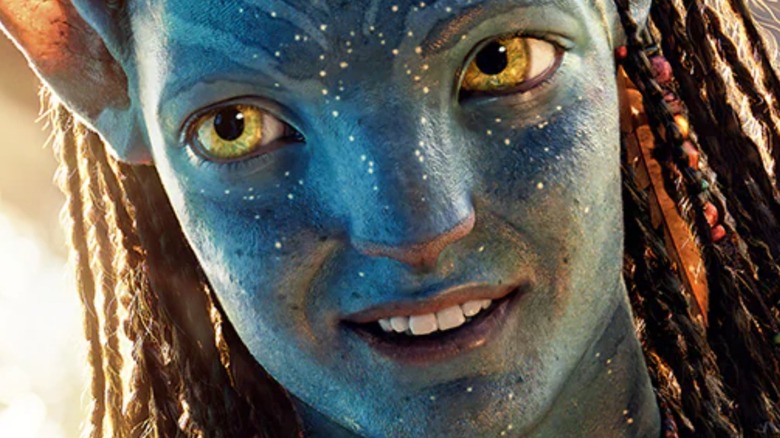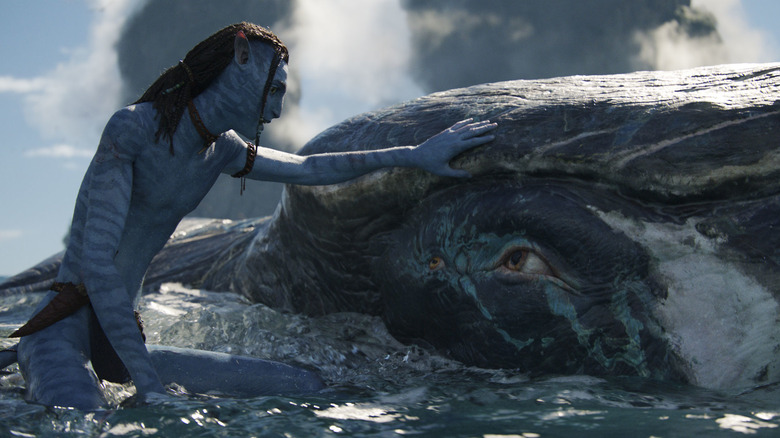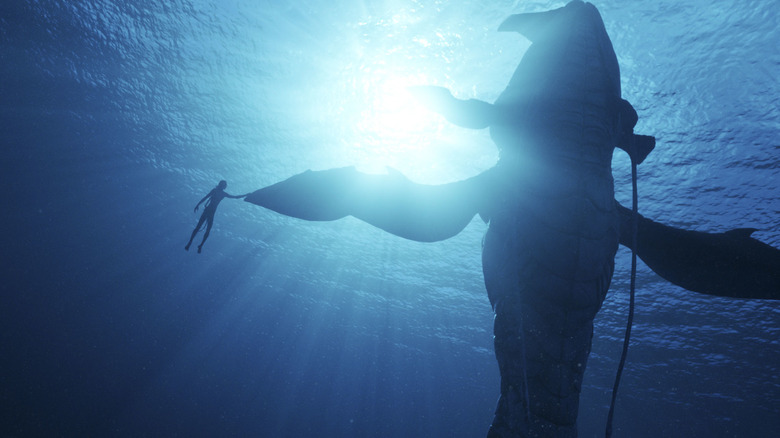It's Time We Talk About The Whales In Avatar: The Way Of Water
This article contains spoilers for "Avatar: The Way of Water."
After 13 long years of anticipation, audiences across the globe finally return to the mesmerizing world of Pandora in "Avatar: The Way of Water." In the sequel to James Cameron's original astonishing sci-fi epic, we catch up with Jake Sully (Sam Worthington) and Neytiri (Zoe Saldaña) 10 years after the first "Avatar" film. In that time, the two Na'vi had a blend of half-human children (differentiated by their number of fingers), including the honorable golden child Neteyam (Jamie Flatters), his rebellious younger brother Lo'ak (Britain Dalton), and adorable youngest sister Tuktirey (Trinity Jo-Li Bliss).
The Na'vi leaders even adopted the human boy Miles "Spider" Socorro (Jack Champion), the estranged son of the notorious Colonel Miles Quaritch (Stephen Lang), and the mystical Kiri (Sigourney Weaver), the mysterious daughter of researcher Dr. Grace Augustine (also played by Sigourney Weaver). These surprising twists add a dramatic layer of personal family conflict and turmoil as an ecological battle elevates the climax of the film. This brings us to the majestic, and colossal alien whale-like Tulkun featured heavily in "Avatar: The Way of Water," particularly the outcast Payakan.
It seems audiences at first didn't know what to make of the Tulkun
After the Na'vi clone version of Colonel Quaritch (as the original died in the first film) attacks Jake and his family in the forests of Pandora, they flee to the oceanic Pandoran sea. There they meet the Metkayina clan led by Tonowari (Cliff Curtis) and Ronal (Kate Winslet), who introduce them to their aquatic way of life. Their children Tsireya (Bailey Bass) and Aonung (Filip Geljo) help Jake and Neytiri's children adapt as well until Aonung plays a dangerous practical joke on Lo'ak. This leaves the young, land-dwelling boy stranded at sea, where a terrifying sea beast attacks him in a suspenseful chase scene. He's suddenly rescued by an enormous Tulkun named Payakan, whose intellect allows it to communicate with Lo'ak.
At first, it seems audiences found the subtitled whale a little goofy, according to users on Reddit. The unconventional bond seemed a bit strange to some viewers, as u/Dawesfan shares, "My audience died of laughter when they put subtitles for the whale. Later we are told the whales are smarter than us. It suddenly makes sense to have them communicate with the Na'vi." Payakan's traumatic backstory unfolds through its unique relationship with Lo'ak to inform the audience that its entire tribe was ravaged by poachers. We later find out that they're seeking the Tulkun's biological fluid, which stops the human aging process entirely and is worth upwards of $80 million a vial.
The character development of Payakan paid off tremendously
That component outlines James Cameron's intentions to parallel our climate anxieties over the real-world oceanic crisis on Earth, which elevates the end of the film into a powerful statement. Payakan comes to help fight Colonel Miles Quaritch and the other poachers in the explosive final battle sequence. The sentient being learns from its attackers and uses their own deadly force against them. Here, the original silly impression made on audiences was instantly erased as Payakan's character journey came full circle.
On Reddit, users share their joy in Payakan's shining battle moment when they bounced a projectile off their horn, ricocheting it back towards the enemies. Crowd cheers which u/schlitzntl notes, "I really enjoyed the setup and payoff of – these whales are maybe even more intelligent than humans – which is then showed off as the whale had learned all the tactics and deliberately baited them into making attacks that it then used to its own advantage. It learned from that first encounter – that whale is no fool."
Audiences' reactions indicate they were overjoyed by Payakan's vengeance, especially after we witnessed the brutal execution of a Tulkun mother. This helps the climate crisis elements present in the Tulkun resonate more deeply with a powerful example in thematic subtext.


